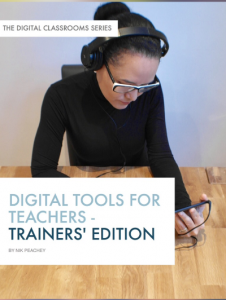Few things divide the opinions of teachers more than the use of technology in the classroom but with more than 20 years of the internet I thought we would have moved on from “Whether?” to “How?” It seems though that I’m mistaken, as France moves to ban mobile devices from their children’s classrooms I’m once again appalled that our education systems can be so out of touch with our students’ day-to-day realities.
Both sides in this debate regularly site research or the lack of it to enforce their arguments that technology should or shouldn’t be used, but much of this research is either very small scale and carried out within a very limited context or looks at how technology can be overlaid onto an antiquated approach to transmission teaching that itself has no foundation in research and was only used in the absence of any other approach.
So, I feel like common sense should be our guide, and here are four reasons why teaching students how to use technology should be a no-brainer.
Developing writing skills
With the vast majority of written discourse being created on digital devices, it would seem only natural that we look to digital tools to assist in both the production of a wide range of text-based genre and also in the teaching of the sub-skills of writing.
 In addition to this, the move to digital text production has enabled the creation of a number of tools that can assist students in the production of better quality writing and supply them with feedback, guidance and suggestions for improving the quality of their output. Many of these kinds of tools don’t exist in the analog world of paper-based production, so it is imperative that we as teachers help to educate our students to enable them to get the best from these tools and resources.
In addition to this, the move to digital text production has enabled the creation of a number of tools that can assist students in the production of better quality writing and supply them with feedback, guidance and suggestions for improving the quality of their output. Many of these kinds of tools don’t exist in the analog world of paper-based production, so it is imperative that we as teachers help to educate our students to enable them to get the best from these tools and resources.
Another significant change that digital text production has ushered in is the ability to produce text collaboratively, both asynchronously and synchronously. The skills involved in working collaboratively to produce and refine text are becoming increasingly important in today’s modern workplace, so again this reinforces the importance of developing students writing skills within the digital realm.
Developing speaking skills
Digital connectivity has brought about a revolution in the way we use voice to communicate both with each other and with the digital devices that accompany us wherever we go. Face-to-face synchronous communication across continents has become a day-to-day experience for many people and the use of voice to control various aspects of our computers and indeed our homes is becoming normalized.
 With the falling cost, increased accessibility, and use of voice communication tools across continents and cultures it seems only natural that we should be helping our students to access and make use of these tools effectively both inside and outside the classroom. These tools don’t just offer our students the opportunity for genuine language use but they also offer them the opportunity to record and reflect on their own abilities and take a more autonomous and self-aware approach to the development of speaking skills.
With the falling cost, increased accessibility, and use of voice communication tools across continents and cultures it seems only natural that we should be helping our students to access and make use of these tools effectively both inside and outside the classroom. These tools don’t just offer our students the opportunity for genuine language use but they also offer them the opportunity to record and reflect on their own abilities and take a more autonomous and self-aware approach to the development of speaking skills.
Developing reading skills
Despite the proliferation and popularity of video and audio on the internet, the vast majority of what is published and consumed online is still text. Reading from screens, websites and digital communication tools present students with some unique challenges that the more linear, homogeneously sealed environment of paper-based communication doesn’t. In contrast to the challenges of reading from a screen, digital tools also offer a range of functionality to support the reading process and make it more engaging and enriching.
 It can also be argued that we now consume text in a very different way on digital devices. We are much more likely to explore background information, take tangental journeys away from the original topic and read across multiple texts and genres during our searches and researches. Developing the skills necessary to read effectively in this new digital environment can only be done using the tools and devices that are native to that environment, so as teachers we need to ensure that we are using a range of digital texts and tools that help students to develop the skills they need to navigate this digital world with confidence.
It can also be argued that we now consume text in a very different way on digital devices. We are much more likely to explore background information, take tangental journeys away from the original topic and read across multiple texts and genres during our searches and researches. Developing the skills necessary to read effectively in this new digital environment can only be done using the tools and devices that are native to that environment, so as teachers we need to ensure that we are using a range of digital texts and tools that help students to develop the skills they need to navigate this digital world with confidence.
Developing listening skills
Much like speaking, the digital communications revolution has expanded access to a huge variety of digital genres and with that a range of voices and accents that students would never experience in the analog classroom.
 These digital communication tools coupled with the proliferation of mobile devices offer students the opportunity to work more autonomously to develop their listening skills both inside and outside the classroom. Helping students to negotiate the huge range of available tools and use them in a way that enables them to develop their listening and communication skills more effectively should be among the top priorities of language teachers.
These digital communication tools coupled with the proliferation of mobile devices offer students the opportunity to work more autonomously to develop their listening skills both inside and outside the classroom. Helping students to negotiate the huge range of available tools and use them in a way that enables them to develop their listening and communication skills more effectively should be among the top priorities of language teachers.
These four short texts come from my ebook – Digital Tools for Teachers – Trainers’ Edition.

Digital Tools for Teachers – Teacher Trainers’ Edition

